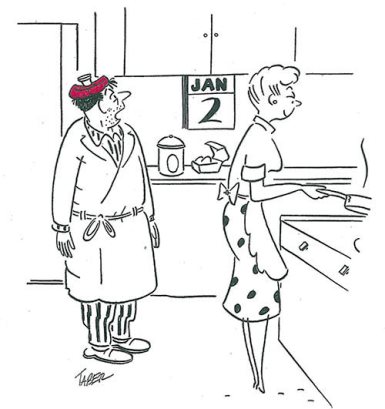Source: August 2014 ACBL Bridge Bulletin ![]()
![]()
![]()
![]()
To score well playing IMPs versus seasoned competition, one necessary ingredient is to pursue vulnerable games aggressively. Game contracts with at least a 40% chance for success should be bid, assuming that the worst outcome is down one, undoubled. In practice, nobody can accurately compute when a contract has exactly a 40% chance, let alone how often the opponents might apply the ax to a doomed contract. What matters is the concept of stretching for vulnerable games.
This raises a partnership issue: If both partners are stretching their values in the same auction, then many hopeless game contracts will be reached. A sensible strategy employs aggressive game tries but conservative acceptances.
After 1![]() -2
-2 ![]() (semi-constructive, 8-10 points), a vulnerable opener should invite game by bidding 3
(semi-constructive, 8-10 points), a vulnerable opener should invite game by bidding 3![]() with:
with: ![]() AKJxxx
AKJxxx ![]() xx
xx ![]() AQxx
AQxx ![]() Ax. Responder should sign off in 3 A unless he holds a perfect mesh that provides a reasonable shot at game, such as:
Ax. Responder should sign off in 3 A unless he holds a perfect mesh that provides a reasonable shot at game, such as: ![]() AQxx
AQxx ![]() xxxx
xxxx ![]() KJ
KJ ![]() AKxxx. The point is that both partners can’t be pushing at the same time. So far, this is probably old hat to experienced IMP players. The accompanying headache comes with declaring these tight vulnerable games.
AKxxx. The point is that both partners can’t be pushing at the same time. So far, this is probably old hat to experienced IMP players. The accompanying headache comes with declaring these tight vulnerable games.
Let’s say that you hold: ![]() A K 7
A K 7 ![]() A K 7 3 2
A K 7 3 2 ![]() 9 4
9 4 ![]() A 10 3 2. IMP scoring, your side vulnerable, you open 1
A 10 3 2. IMP scoring, your side vulnerable, you open 1![]() and partner raises to 2
and partner raises to 2![]() . Adopting the aggressive game-try strategy, you bid 3
. Adopting the aggressive game-try strategy, you bid 3![]() . Partner, accepting game tries conservatively, bids 4
. Partner, accepting game tries conservatively, bids 4![]() , ending the auction.
, ending the auction.
Partner certainly has a fitting maximum. The lead is a fourth-best ![]() 2. East wins the ace and returns the
2. East wins the ace and returns the ![]() 9, West following. What’s your plan? Assuming that the clubs run, you might lose three more tricks – two diamonds and a heart – one trick too many. You could bang down the top hearts, hoping for queen-doubleton, and then lead a diamond toward dummy’s king. If you get lucky in either red suit, the contract comes home.
9, West following. What’s your plan? Assuming that the clubs run, you might lose three more tricks – two diamonds and a heart – one trick too many. You could bang down the top hearts, hoping for queen-doubleton, and then lead a diamond toward dummy’s king. If you get lucky in either red suit, the contract comes home.
There is, however, a better approach: make a discovery play before tackling hearts. Let’s say that you lead a diamond at trick three. West wins the ace and returns a diamond. If the ![]() A had been offside, you would need to play the hearts for no losers by cashing the ace and the king. Instead, you now have the luxury of losing one heart trick but not two. A safety play option materializes: cash one top heart and lead low toward dummy’s remaining
A had been offside, you would need to play the hearts for no losers by cashing the ace and the king. Instead, you now have the luxury of losing one heart trick but not two. A safety play option materializes: cash one top heart and lead low toward dummy’s remaining ![]() J 5. The gain comes when West was dealt queen-fourth of hearts in a hand like:
J 5. The gain comes when West was dealt queen-fourth of hearts in a hand like:
![]() Q10xx
Q10xx ![]() Q10xx
Q10xx ![]() AQx
AQx ![]() Axx. The safety play reduced your heart losers to one, where as cashing the top hearts loses two trump tricks and scuttles the contract.
Axx. The safety play reduced your heart losers to one, where as cashing the top hearts loses two trump tricks and scuttles the contract.
Playing IMPs, your top priority is to safeguard the contract, even at the expense of an overtrick. Rather than pass 2![]() and languish in an easy partial, you made an aggressive game try and won double-digit IMPs (or averted the loss of same). Your early diamond play clarified your objective in the trump suit either go all-out for no losers or utilize the safety play to minimize the chance of two losers.
and languish in an easy partial, you made an aggressive game try and won double-digit IMPs (or averted the loss of same). Your early diamond play clarified your objective in the trump suit either go all-out for no losers or utilize the safety play to minimize the chance of two losers.

